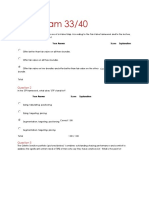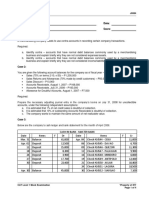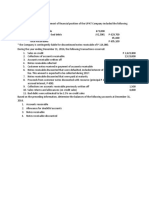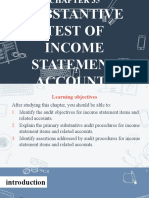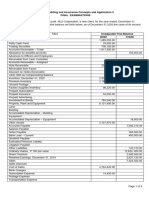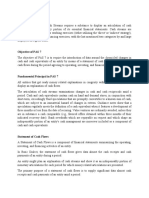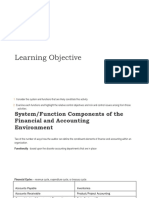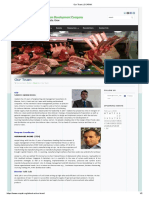0 ratings0% found this document useful (0 votes)
230 viewsNiat Reviewer
Niat Reviewer
Uploaded by
Mae leeThis document discusses key concepts in accounting including the qualitative characteristics of useful financial information, types of businesses, forms of business organization, the accounting cycle, basic assumptions and principles of accounting, and basic financial statements. The most important qualitative characteristics are relevance, predictive value, and faithful representation which ensure financial information is useful to decision makers. There are four main types of businesses - service, merchandising, manufacturing, and hybrid - and four main forms of business organization - sole proprietorship, partnership, corporation, and cooperative.
Copyright:
© All Rights Reserved
Available Formats
Download as DOCX, PDF, TXT or read online from Scribd
Niat Reviewer
Niat Reviewer
Uploaded by
Mae lee0 ratings0% found this document useful (0 votes)
230 views2 pagesThis document discusses key concepts in accounting including the qualitative characteristics of useful financial information, types of businesses, forms of business organization, the accounting cycle, basic assumptions and principles of accounting, and basic financial statements. The most important qualitative characteristics are relevance, predictive value, and faithful representation which ensure financial information is useful to decision makers. There are four main types of businesses - service, merchandising, manufacturing, and hybrid - and four main forms of business organization - sole proprietorship, partnership, corporation, and cooperative.
Copyright
© © All Rights Reserved
Available Formats
DOCX, PDF, TXT or read online from Scribd
Share this document
Did you find this document useful?
Is this content inappropriate?
This document discusses key concepts in accounting including the qualitative characteristics of useful financial information, types of businesses, forms of business organization, the accounting cycle, basic assumptions and principles of accounting, and basic financial statements. The most important qualitative characteristics are relevance, predictive value, and faithful representation which ensure financial information is useful to decision makers. There are four main types of businesses - service, merchandising, manufacturing, and hybrid - and four main forms of business organization - sole proprietorship, partnership, corporation, and cooperative.
Copyright:
© All Rights Reserved
Available Formats
Download as DOCX, PDF, TXT or read online from Scribd
Download as docx, pdf, or txt
0 ratings0% found this document useful (0 votes)
230 views2 pagesNiat Reviewer
Niat Reviewer
Uploaded by
Mae leeThis document discusses key concepts in accounting including the qualitative characteristics of useful financial information, types of businesses, forms of business organization, the accounting cycle, basic assumptions and principles of accounting, and basic financial statements. The most important qualitative characteristics are relevance, predictive value, and faithful representation which ensure financial information is useful to decision makers. There are four main types of businesses - service, merchandising, manufacturing, and hybrid - and four main forms of business organization - sole proprietorship, partnership, corporation, and cooperative.
Copyright:
© All Rights Reserved
Available Formats
Download as DOCX, PDF, TXT or read online from Scribd
Download as docx, pdf, or txt
You are on page 1of 2
TYPES OF BUSINESS QUALITATIVE CHARACTERISTICS OF USEFUL FINANCIAL INFORMATION
Service Business - provides intangible products (products with no Fundamental qualitative characteristics
physical form). Service type firms offer professional skills, expertise,
advice, and other similar products. Examples of service businesses are: Relevance - Information that is capable of making a difference in the
salons, repair shops, schools, banks, accounting firms, and law firms. decisions of users in their capacity as capital providers.
Merchandising Business – They buys products at wholesale price and Predictive value - Information about an economic phenomenon that has
sells the same at retail price. They are known as "buy and sell" value as an input to the processes used by capital providers to form their
businesses. They make profit by selling the products at prices higher own expectations about the future.
than their purchase costs. A merchandising business sells a product Conformity value – Information should be helpful to decision makers who
without changing its form. Examples are: grocery stores, convenience are validating, making updates, adjustments or corrections to past
stores, distributors, and other resellers. predictions.
Manufacturing Business - Buys products with the intention of using Materiality - Information is material if omitting, misstating or obscuring it
them as materials in making a new product. Thus, there is a could reasonably be expected to influence decisions that the primary users of
transformation of the products purchased. A manufacturing business general purpose financial reports
combines raw materials, labor, and overhead costs in its production Faithful representation – Information must contain factual transactions and
process. The manufactured goods will then be sold to customers. other events it purports to represent. To be a perfectly faithful
Hybrid Business – are companies that may be classified in more than representation. It would be complete, neutral and free from error.
one type of business. A restaurant, for example, combines ingredients Completeness- Financial reports must contain all necessary information that
in making a fine meal (manufacturing), sells a cold bottle of wine would influence economic decision.
(merchandising), and fills customer orders (service). Neutrality - Absence of bias intended to attain a predetermined result or to
induce a particular behavior.
FORMS OF BUSINESS ORGANIZATION Information is neutral when it is fair or free from bias toward a desired result
or behavior.
1. Sole Proprietorship - is a business owned by only one person. It is easy to Free from error – Information must be free from material error to faithfully
set-up and is the least costly among all forms of ownership. The owner embody the representation contained therein.
faces unlimited liability; meaning, the creditors of the business may go after
the personal assets of the owner if the business cannot pay them. The sole Enhancing qualitative characteristics
proprietorship form is usually adopted by small business entities. Comparability - Quality of information that permits users to identify
2. Partnership – is a business owned by two or more persons who contribute similarities in and differences between two sets of economic phenomena.
resources into the entity. The partners divide the profits of the business Verifiability - helps assure users that information faithfully represents the
among themselves. In general partnerships, all partners have unlimited economic phenomena it purports to represent.
liability. In limited partnerships, creditors cannot go after the personal assets Direct Verification - means verifying an amount or other
of the limited partners. representation through direct observation,
3. Corporation - is a business organization that has a separate legal Indirect verification - means checking the inputs to a model,
personality from its owners. Ownership in a stock corporation is represented formula or other technique and recalculating the outputs using the same
by shares of stock. methodology.
4.Cooperative - is a business organization owned by a group of individuals Understandability - quality of information that allows users to comprehend
and is operated for their mutual benefit. The persons making up the group its meaning.
are called members. Cooperatives may be incorporated or unincorporated. Timeliness - Having information available to users before it loses its capacity
Some examples of cooperatives are: water and electricity (utility) to influence decisions.
cooperatives, cooperative banking, credit unions, and housing cooperatives.
BASIC ASSUMPTIONS IN ACCOUNTING
FUNCTIONS OF ACCOUNTING
1.Economic Entity Assumption - Indicates that personal and business record
Recording (in journal book)
keeping should be separately maintained.
Classifying (ledger)
2.Going Concern Assumption – Assumes that the entity will continue
Summarizing (worksheet)
operating indefinitely for a period of time. Rationale why plant assets are not
Analyzing and Interpreting reported at liquidation value.
Communicating Objectivity – All documents used in record keeping must be
Protecting the property of the business i evidenced by a source document that identifies the actual cost incurred.
Preparing legal requirements Historical Cost – Helps to attain objectivity by considering only the
purchase price as the value of an asset. Once recorded, it remains
ACCOUNTING CYCLE
unchanged.
1.Identification of transactions 3.Monetary Unit Assumption – Assumes that money is the common
2.Journalizing the transaction. (recording in journal) denominator in measuring economic entity.
3.Posting from the Journals to General Ledger. 4.Periodicity (Time Period) Assumptions - Separates financial information
4.Preparing the Unadjusted Trial Balance. into time periods for reporting purposes.
5.Recording Adjusting Entries. Time Period – called an accounting period, it classified as either:
6.Preparing the Adjusted Trial Balance. Calendar year - 12 months period which starts from Jan.1 to Dec.
7.Preparing Financial Statements. 31 of the accounting period
8.Recording Closing Entries. Fiscal year – With 12 months but starts from any month other
9.Preparing a Post-Closing Trial Balance. than January.
10. Recording Reversing Entries. Interim Period – Business period within an accounting period. (weekly,
monthly, quarterly, semi-annual)
5.Accrual-Basis Assumption –Provides information about past transactions
and other future economic events that are most useful to users in making of
economic decisions.
BASIC PRINCIPLES OF ACCOUNTING
Measurement Principle
1.Cost Principle – also known as historical cost principle. Indicates that fair
value changes subsequent to purchase are not recorded in the accounts.
2.Fair Value Principle - Permits the use of fair value valuation in certain
situations.
BASIC FINANCIAL STATEMENTS
Financial Statements – formal reports prepared by accountants.
1.Statement of Financial Position – also known as the Balance Sheet shows
the financial condition of the business entity at any given time.
Elements: ASSETS, LIABILITIES & EQUITY
2.Statement of Comprehensive Income – also known as Income Statement it
shows the operating performance of the business entity for a given period.
Elements: Revenues and Expenses
3.Statement of Changes in Equity – (Capital Statement) – shows the
movements in the various elements of the capital for a certain period.
4. Cash Flow Statement – Explain the changes of cash and cash equivalents
during an accounting period.
a. Operating – the inflows and outflows of cash from the normal
operating activities of the business.
b. Investing – the inflows and outflows of cash from the sale or
purchase of assets other than inventory.
c. Financing – the inflows and outflows of cash from the owners
and creditors of the enterprise.
5. Notes to the Financial Statements
You might also like
- Burger KingDocument17 pagesBurger KingManan MehtaNo ratings yet
- Final Exam Marketing PDFDocument17 pagesFinal Exam Marketing PDFAarush AggarwaLNo ratings yet
- EXERCISE ON ADJUSTING ENTRIES - Corrected VersionDocument2 pagesEXERCISE ON ADJUSTING ENTRIES - Corrected VersionRoy BonitezNo ratings yet
- Assurance and Assurance Related Services-Review, Compilation, Profit Forecast, Agreed Upon Procedures and OthersDocument82 pagesAssurance and Assurance Related Services-Review, Compilation, Profit Forecast, Agreed Upon Procedures and OthersWanqi LooNo ratings yet
- Client Acceptance and ContinuanceDocument7 pagesClient Acceptance and ContinuanceGina100% (1)
- Computerised Accounting Practice Set Using MYOB AccountRight - Advanced Level: Australian EditionFrom EverandComputerised Accounting Practice Set Using MYOB AccountRight - Advanced Level: Australian EditionNo ratings yet
- Gcreddy PDFDocument17 pagesGcreddy PDFVeerraghavaReddyNo ratings yet
- J.C. Penny 2019 Toy CatalogDocument18 pagesJ.C. Penny 2019 Toy CatalogKyle Hicks0% (1)
- Chapter8 Fiancial Reporting by James HallDocument43 pagesChapter8 Fiancial Reporting by James Hallkessa thea salvatoreNo ratings yet
- AC13.1.1 Module 1 - Provisions, Contingencies, and Other LiabilitiesDocument15 pagesAC13.1.1 Module 1 - Provisions, Contingencies, and Other LiabilitiesRenelle HabacNo ratings yet
- Chapter 2 Business ProcessesDocument2 pagesChapter 2 Business ProcessesChristlyn Joy BaralNo ratings yet
- Expectations AssumptionsDocument15 pagesExpectations AssumptionsPrasunkumar PandeyNo ratings yet
- Client Selection and RetentionDocument20 pagesClient Selection and RetentionJurie MayNo ratings yet
- CAT Level 1 Mock Examination-1Document4 pagesCAT Level 1 Mock Examination-1Nadine ReidNo ratings yet
- Applied Auditing - ReceivablesDocument2 pagesApplied Auditing - ReceivablesGlen Mervin EsguerraNo ratings yet
- PRELEC 1 Updates in Managerial Accounting Notes PDFDocument6 pagesPRELEC 1 Updates in Managerial Accounting Notes PDFRaichele FranciscoNo ratings yet
- A Complete Set of Financial Statements ComprisesDocument9 pagesA Complete Set of Financial Statements Comprisesۦۦۦۦۦ ۦۦ ۦۦۦNo ratings yet
- Chapter 2-Audits of Financial Statements PDFDocument23 pagesChapter 2-Audits of Financial Statements PDFCaryll Joy BisnanNo ratings yet
- At 01 Practice and Regulation of The Accountancy Profession1Document17 pagesAt 01 Practice and Regulation of The Accountancy Profession1ace100% (1)
- Johnstone 9e Auditing Chapter3 PPtFINALDocument82 pagesJohnstone 9e Auditing Chapter3 PPtFINALLeizza Ni Gui Dula100% (1)
- Chapter 9 PDFDocument17 pagesChapter 9 PDFJasmine LimNo ratings yet
- Theory of AccountsDocument8 pagesTheory of AccountsAcain RolienNo ratings yet
- Audit of The Financing and Investing Cycle ReportDocument20 pagesAudit of The Financing and Investing Cycle ReportCyrell S. SaligNo ratings yet
- Mikong Due MARCH 30 Hospital and HmosDocument6 pagesMikong Due MARCH 30 Hospital and HmosCoke Aidenry SaludoNo ratings yet
- Substantive Test of Income Statement AccountsDocument25 pagesSubstantive Test of Income Statement AccountsAldrin John TungolNo ratings yet
- APPLIED AUDITING Module 1Document3 pagesAPPLIED AUDITING Module 1Paul Fajardo CanoyNo ratings yet
- Chapter 8 Financial Reporting and Management Reporting SystemsDocument45 pagesChapter 8 Financial Reporting and Management Reporting SystemsIc Sherenne ValeNo ratings yet
- Guide On Cooperative Audit PDFDocument25 pagesGuide On Cooperative Audit PDFNichole DouglasNo ratings yet
- Chapter 18 Inventory and Production ManagementDocument12 pagesChapter 18 Inventory and Production ManagementCelestaire LeeNo ratings yet
- Relevant Costs For Non Routine Decision MakingDocument46 pagesRelevant Costs For Non Routine Decision Makingallaccessa01No ratings yet
- (Jpia) Chapter 1 - New Conceptual Framework Lecture & ExerciseDocument3 pages(Jpia) Chapter 1 - New Conceptual Framework Lecture & ExerciseMaureen Derial PantaNo ratings yet
- Auditing and Assurance Concepts and Application 2 - Final ExaminationDocument9 pagesAuditing and Assurance Concepts and Application 2 - Final ExaminationHannah SyNo ratings yet
- Auditing Notes.18Document37 pagesAuditing Notes.18sasikumarthanus100% (1)
- Steps in Audit Engagement CDocument5 pagesSteps in Audit Engagement CReland CastroNo ratings yet
- Notes Receivable and Loan ReceivableDocument21 pagesNotes Receivable and Loan ReceivableLady BelleNo ratings yet
- Investments Questions For Review of Key Topics: Question 8-1Document85 pagesInvestments Questions For Review of Key Topics: Question 8-1kean ebeoNo ratings yet
- CHAPTER I and IIDocument13 pagesCHAPTER I and IIPritz Marc Bautista MorataNo ratings yet
- LEARNING MODULE-Financial Accounting and ReportingDocument7 pagesLEARNING MODULE-Financial Accounting and ReportingAngelica SamboNo ratings yet
- MODULE AEC9 Business LogicDocument111 pagesMODULE AEC9 Business LogicCarmi Fecero100% (1)
- PAS 7 and PAS 41 SummaryDocument5 pagesPAS 7 and PAS 41 SummaryCharles BarcelaNo ratings yet
- Auditing Theories Reviewer For CplaDocument63 pagesAuditing Theories Reviewer For CplaNoella Marie BaronNo ratings yet
- HBO - Chapter 1-3Document9 pagesHBO - Chapter 1-3Shalimar De ManuelNo ratings yet
- Cost Accounting Reviewer Chapter 1: Introduction To Cost AccountingDocument38 pagesCost Accounting Reviewer Chapter 1: Introduction To Cost AccountingJoyce MacatangayNo ratings yet
- Audit Rev. 3Document4 pagesAudit Rev. 3Charles PolidoNo ratings yet
- Inherent Limitations of An AuditDocument2 pagesInherent Limitations of An AuditVarun Shah VO-TVNo ratings yet
- OpAudCh04 CBET 01 501E Toralde, Ma - Kristine E.Document5 pagesOpAudCh04 CBET 01 501E Toralde, Ma - Kristine E.Kristine Esplana ToraldeNo ratings yet
- Self-Instructional Manual (SIM) For Self-Directed Learning (SDL)Document64 pagesSelf-Instructional Manual (SIM) For Self-Directed Learning (SDL)almira garciaNo ratings yet
- Auditing Finance and Accounting FunctionsDocument14 pagesAuditing Finance and Accounting FunctionsApril ManjaresNo ratings yet
- Chapter 14 Multiple Choice, Government and Non For ProfitDocument9 pagesChapter 14 Multiple Choice, Government and Non For Profitcpierre08100% (1)
- CH 12 - Fraud and ErrorDocument5 pagesCH 12 - Fraud and ErrorJwyneth Royce DenolanNo ratings yet
- Intermediate Accounting Practice QuestionsDocument4 pagesIntermediate Accounting Practice QuestionsYsa Acupan100% (2)
- An Analysis of The Inventory Management System (Case Study)Document9 pagesAn Analysis of The Inventory Management System (Case Study)Imelda Maria Tania RosarioNo ratings yet
- BUKU - Blocher Et Al-Cost Management - A Strategic Emphasis, 5th Edition (2009) - 127-179 PDFDocument53 pagesBUKU - Blocher Et Al-Cost Management - A Strategic Emphasis, 5th Edition (2009) - 127-179 PDFelis100% (1)
- FAR Practice ProblemsDocument34 pagesFAR Practice ProblemsJhon Eljun Yuto EnopiaNo ratings yet
- ADVANCED ACCOUNTING Chapter 6Document90 pagesADVANCED ACCOUNTING Chapter 6Stork EscobidoNo ratings yet
- CFAS INTRo1Document14 pagesCFAS INTRo1Hannah Pamela LegaspiNo ratings yet
- Basic Consideration in MAS Management Accounting EnvironmentDocument25 pagesBasic Consideration in MAS Management Accounting EnvironmentLeslie Beltran Chiang100% (1)
- Chapter 7 The Balanced Scorecard A Tool To Implement Strategy SoftDocument20 pagesChapter 7 The Balanced Scorecard A Tool To Implement Strategy SoftDjunah ArellanoNo ratings yet
- Financial Analysis of Perpetual Help Community Cooperative (PHCCI)Document17 pagesFinancial Analysis of Perpetual Help Community Cooperative (PHCCI)Jasmine Lilang ColladoNo ratings yet
- Ballada Chap 1 ReviewerDocument3 pagesBallada Chap 1 ReviewerJullianneBalaseNo ratings yet
- Conceptual Framework and Accounting Standards NotesDocument2 pagesConceptual Framework and Accounting Standards NotesKing Nufayl SendadNo ratings yet
- MAS Reviewer: Management Accounting: AnDocument16 pagesMAS Reviewer: Management Accounting: AnWilmer PascuaNo ratings yet
- Accounting Information System A Complete Guide - 2020 EditionFrom EverandAccounting Information System A Complete Guide - 2020 EditionRating: 1 out of 5 stars1/5 (1)
- Rural Marketing Assignment 3rd DecemberDocument3 pagesRural Marketing Assignment 3rd DecemberAnuth SiddharthNo ratings yet
- Quality of Health Care - Gashaw PDFDocument76 pagesQuality of Health Care - Gashaw PDFKokebu MekonnenNo ratings yet
- Global Village Framework-2Document196 pagesGlobal Village Framework-2Adhelansyah Gamar PutraNo ratings yet
- Sale of Goods ActDocument24 pagesSale of Goods ActAshaduzaman LimonNo ratings yet
- Term Paper Course Code: BSL304 Max. Marks: 40 No Questions 1Document2 pagesTerm Paper Course Code: BSL304 Max. Marks: 40 No Questions 1Sai Ram BachuNo ratings yet
- Cobit 5Document3 pagesCobit 5Prihantoro Tri NugrohoNo ratings yet
- Over Head Gantry DrawingDocument1 pageOver Head Gantry DrawingDevendra KirarNo ratings yet
- West Bengal Health Recruitment Board: WWW - Wbhrb.inDocument4 pagesWest Bengal Health Recruitment Board: WWW - Wbhrb.inSouvik Basu RnsNo ratings yet
- The Banking Environment Initiative Sustainable Shipment Letter of Credit - 1Document25 pagesThe Banking Environment Initiative Sustainable Shipment Letter of Credit - 1ShirleyNo ratings yet
- BCO1 - Group1 Final DraftDocument4 pagesBCO1 - Group1 Final DraftethanjovanhodgespillayNo ratings yet
- R38 Dividends and Share Repurchases Basics Q BankDocument12 pagesR38 Dividends and Share Repurchases Basics Q BankAhmedNo ratings yet
- Advertising and Promotion Report Marketing Plan Kick Smoke GumDocument24 pagesAdvertising and Promotion Report Marketing Plan Kick Smoke GumRaja Ahsan Javed100% (1)
- Correction of ErrorsDocument13 pagesCorrection of ErrorsHftc SamNo ratings yet
- Bench MarketingDocument55 pagesBench Marketinggs037No ratings yet
- BT RatesDocument33 pagesBT RatesKishore Babu Pvr100% (2)
- Sworn Affidavit of Service by MessengerDocument4 pagesSworn Affidavit of Service by Messengerjasmin coNo ratings yet
- Soal PASDocument70 pagesSoal PASMaya KristiansyahNo ratings yet
- Pakistan Cold ChainDocument2 pagesPakistan Cold ChainMohammad Khalil AjmalNo ratings yet
- ComputerDocument35 pagesComputerShainnaJane Panganiban PorteNo ratings yet
- GST Under Reverse Charge On Goods Transport Agency (GTA)Document2 pagesGST Under Reverse Charge On Goods Transport Agency (GTA)Deepak NimmojiNo ratings yet
- Creative Solutions & CoDocument58 pagesCreative Solutions & CoMuhammad MianNo ratings yet
- Sase Reviewer MathDocument7 pagesSase Reviewer Mathtravelflight22No ratings yet
- Manpower Training and Development For Sustainable JobDocument5 pagesManpower Training and Development For Sustainable JobMuhammad Indra PrajaNo ratings yet
- MAS 1 - Standard Cost and Variance AnalysisDocument2 pagesMAS 1 - Standard Cost and Variance AnalysisKris FernandezNo ratings yet
- Trusts Introductions EssayDocument2 pagesTrusts Introductions Essayapi-234400353100% (1)
- My Resume Personal Particular: Experiences As An EmployeeDocument3 pagesMy Resume Personal Particular: Experiences As An EmployeeArdiansyah PribadiNo ratings yet


